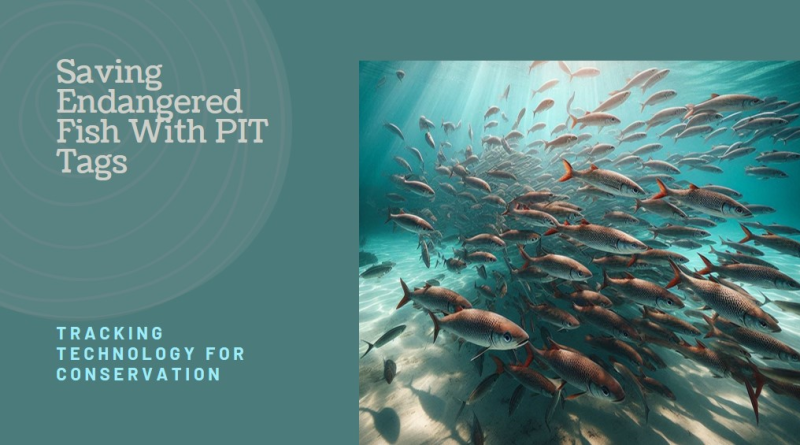The Impact of PIT Tags on Endangered Fish Conservation
Conservation efforts for endangered fish species have always been a challenging and resource-intensive endeavor. With an increasing number of fish populations threatened by habitat destruction, climate change, and overfishing, scientists and conservationists have sought innovative solutions to track, monitor, and understand these species. One of the game-changing tools that have risen to prominence is the Passive Integrated Transponder (PIT) tag. These tiny, battery-free devices are revolutionizing fish conservation, offering invaluable insights into migration patterns, population dynamics, and survival rates.
In this article, we’ll explore how Pit tags fish are being used in conservation efforts to protect endangered fish species, highlight some real-world examples, and explain why they are so crucial for the future of aquatic ecosystems.
What Are PIT Tags?
A PIT tag, or Passive Integrated Transponder, is a small microchip encapsulated in a biocompatible glass that can be implanted in fish and other wildlife. Unlike traditional tagging methods, PIT tags do not require a power source. Instead, they rely on external RFID readers to activate and read the unique identification code each tag carries. PIT tags fish can be easily monitored throughout their lifespan, providing an efficient way to gather long-term data without the need for frequent recaptures.
Why PIT Tags Are Ideal for Endangered Fish Conservation
Several factors make PIT tags ideal for use in conservation:
- Minimal Stress on the Fish: Pit tags fish are small, generally measuring between 8 to 12 millimeters, and cause minimal harm to the fish when implanted. This means endangered fish species can be tagged without adversely affecting their health or behavior.
- Durability: Once implanted, PIT tags remain functional for the lifetime of the fish, offering long-term data collection without requiring frequent handling.
- Data Accuracy: Since each PIT tag contains a unique code, researchers can accurately track individual fish over extended periods. This allows for precise data collection on movements, survival, and reproduction.
- Scalability: PIT tagging systems can track large numbers of fish across multiple locations, making them scalable for population-wide studies.
The Role of PIT Tags in Conservation Research
One of the primary goals of using PIT tags is to gather data that can inform conservation strategies. For endangered species, such data is crucial to understanding the factors that threaten their survival and how to mitigate those threats. Here are some of the key ways PIT tags are aiding conservation efforts:
1. Tracking Migration Patterns
Many fish species, particularly those listed as endangered, depend on migration for their survival. Salmon, for example, travel between freshwater and saltwater habitats during different life stages. PIT tags have proven to be incredibly effective in tracking these migrations. For example, in the Pacific Northwest of the United States, researchers have used Pit tags fish to monitor endangered Chinook salmon populations. By placing RFID readers in key migration routes, scientists can track each tagged fish’s journey, providing critical data on migration timing, survival rates, and habitat use.
This information allows conservationists to identify barriers to migration, such as dams, and develop solutions like fish ladders or dam modifications to facilitate safer passages. Without PIT tags, understanding these intricate movements would be far more difficult.
2. Assessing Population Dynamics
Understanding the size and structure of endangered fish populations is essential for effective conservation. PIT tagging enables scientists to monitor population dynamics in real-time. For instance, researchers studying the endangered Colorado Pikeminnow in the Colorado River have been able to track individual fish over decades, gathering data on growth rates, reproduction, and mortality. Such long-term studies are invaluable for assessing the overall health of a species and evaluating the effectiveness of conservation efforts.
By analyzing data from tagged individuals, conservationists can also estimate population sizes, growth rates, and survival probabilities. This information is vital for making informed decisions about fishing limits, habitat restoration, and breeding programs.
3. Survival Rates and Threat Detection
Another critical use of PIT tags is in determining survival rates of endangered fish. PIT tag monitoring can reveal whether individuals are successfully surviving through different life stages, such as juvenile to adult, or if mortality rates are unusually high due to environmental stressors like pollution, predation, or habitat loss.
For example, in European rivers, scientists have used PIT tags to study the survival of endangered eels. Data collected from tagged eels revealed that pollution and dam barriers were significantly affecting their survival, leading to targeted conservation actions like habitat clean-up and fish passage improvements.
4. Evaluating Conservation Interventions
When conservationists implement recovery programs, such as breeding and release initiatives, PIT tags allow them to track the success of these efforts. Released fish can be tagged and monitored to determine their ability to survive, migrate, and reproduce in the wild.
In some cases, PIT tags have been instrumental in refining conservation techniques. The endangered pallid sturgeon, native to the Missouri and Mississippi Rivers, has been part of an extensive hatchery and release program. By tagging these fish, scientists have been able to assess which release methods are most effective in promoting survival and integration into wild populations.
Commercial Applications and the Role of Voda IQ
Commercial companies like Voda IQ are at the forefront of PIT tag technology, providing cutting-edge RFID solutions for fish tracking in conservation efforts. With robust PIT tag readers and innovative software, Voda IQ has enabled marine researchers and conservationists to gather precise, real-time data on endangered species. Their technology facilitates large-scale fish tracking projects, helping researchers and governments make data-driven decisions for species recovery.
Voda IQ’s solutions stand out because of their reliability in harsh marine environments, ensuring that even the most remote locations can be monitored effectively. With the help of companies like Voda IQ, the use of Pit tags fish in conservation is set to grow, expanding our ability to protect endangered fish species.
Real Data: The Impact of PIT Tags on Conservation Efforts
The use of PIT tags has already made a measurable impact on the conservation of endangered fish species. A study published by the U.S. Fish and Wildlife Service in 2020 found that fish tagging, including PIT tags, had contributed to a 25% increase in survival rates for tagged species. Similarly, research on Atlantic salmon in the UK showed that PIT tags helped identify key breeding areas, leading to targeted conservation efforts that boosted population numbers by 15% over five years.
These examples underscore the effectiveness of PIT tagging in real-world conservation scenarios, where accurate data is often the key to saving species from extinction.
The Future of PIT Tagging in Conservation
As climate change and human activities continue to threaten aquatic ecosystems, the need for effective conservation tools has never been greater. PIT tags offer a scalable, efficient solution that allows researchers to gather essential data without causing undue stress on the animals being studied. As technology advances, the capabilities of PIT tags are likely to expand, enabling even more sophisticated monitoring and data collection techniques.
Moreover, as more institutions and governments adopt PIT tagging technology, it could lead to broader, coordinated efforts across regions, improving the chances of recovery for endangered species worldwide.
FAQs
1. How do Pit tags fish differ from other tagging methods?
PIT tags are unique in that they do not require batteries and can last for the lifetime of the fish. Unlike visual tags or radio transmitters, PIT tags offer long-term, individual tracking without regular maintenance.
2. Can PIT tags be used for any fish species?
Yes, PIT tags can be implanted in a wide range of fish species, from small minnows to large sturgeon. The biocompatible design makes them suitable for both freshwater and marine environments.
3. How do PIT tags help in migration studies?
PIT tags allow scientists to track fish movements across large distances, providing detailed data on migration routes, timing, and survival. This helps conservationists identify threats along migration paths.
4. How long do PIT tags last?
PIT tags are designed to last for the entire life of the fish, providing continuous tracking without the need for battery replacement.
Conclusion
The use of Pit tags fish has become a critical component in the fight to conserve endangered fish species. By providing accurate, long-term data on individual fish, these tags help scientists and conservationists better understand migration patterns, population dynamics, and survival rates. Companies like Voda IQ are helping push this technology forward, offering scalable solutions that make a real difference in the field.
As we look to the future, how can PIT tagging further improve the conservation of endangered aquatic species?
Also know about The Amazing Marine Life at SeaWorld Abu Dhabi: An Overview



